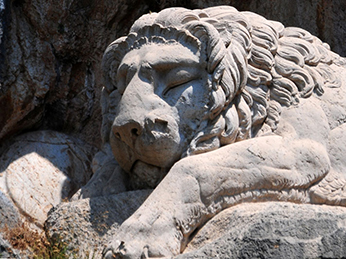SIGHTSEEING
SIGHTSEEING IN NAFPLIO
A place full of attractions and natural beauty.

PALAMIDI
Palamidi (Greek: Παλαμήδι) is a huge, well-maintained and probably the best castle in Greece and the finest sample of the Venetian fortifications in Greece. It was built in 1714 by the Venetians, within the record time of 3 years during their second occupation of the area (1686-1715). The fortress was a big and ambitious project, but was finished within a relatively short period from 1711 until 1714. One of the bastions, called the “Miltiades,” was used as the prison cell of Theodoros Kolokotronis, a hero of the Greek Revolution. There are 857 steps in the winding stair from the town to the fortress. However, to reach the top of the fortress there are over one thousand. The fortress commands an impressive view over the Argolic Gulf, the city of Náfplio and the surrounding country.
THE LAND GATE
Underneath the imposing walls of Acronafplia and in front of the first buildings of the Old City, there is a monument which will definitely catch your eye; it is the Land Gate. It can be your meeting point during your holidays in the city of Nafplion. While admiring it, a simple question might come to your mind; why is it called the Land Gate while there is no sea around? Well, no matter how odd it probably seems nowadays, the gate was the only entrance to the city of Nafplion. In front of the gate there was a wide sea canal, in which small boats moored. The canal started from the walls of Acronafplia, on the left of the gate, and reached the naval yard (At the same place, today, lies a swimming pool). The Gate was of paramount importance during the age of the Venetian rule.
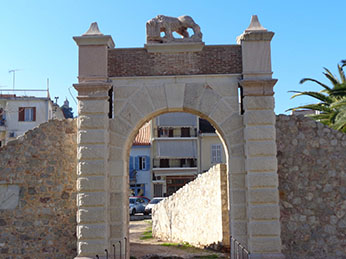

AKRONAFPLIA
Akronafplia is the imposing rocky peninsula that once was the Acropolis of Nafplio. The Turks used to call it “Its-Kale” that means “inside the fortress”. You can approach the castle and admire the unique view with many ways: You can go east at Staikopoulos Park and from the Arvanitias square, or you can walk through the “dromoskala” of the Catholic Church and the gate of the Castle of Toroni.
THE CLOCK TOWER
We will meet it in front of you, going up the road that passes through the Akronafplia. Here is where you can rest and admire the grandeur and beauty of the old city, which lies at your feet. The clock was placed in Akronafplia by king Othona, when mayor of the city was doctor Epaminondas Kotsonopoulou (1866-1878 and 1883-1890). It was a donation of Othonas father Loudovikos A, from Bavaria. Undoubtedly this is the most beautiful part of the city, to enjoy the sunset. Do not forget to have a camera with you. Amazing is the poem written by Emmanuel Terzakis the day of its destruction and which was published in September of 1949 in the newspaper Constitution.
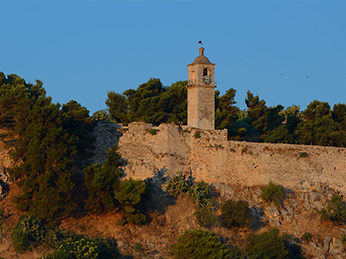
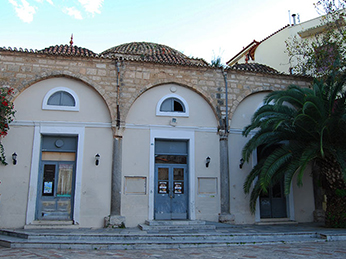
TRIANON – THE OLD TZAMI
One of the oldest surviving buildings from the period of the first Ottoman domination, is the Old Tzami (Mosque), which adorns the center of the city of Nafplio. The beautiful building that is located in the Syntagma Square, nowadays it is know as “Trianon” and was during the Ottoman years, a space of religion. The old mosque is perhaps the oldest example of Ottoman architecture, in the town of Nafplio. Today many theatrical performances, art exhibitions and schools events are organized at Trianon.
SINTAGMATOS SQUARE
Once you are in the shadow of platanos -mentioned above- think of how important the spot is, since, several years ago, revolutionary plans were decided by chieftains. The square -really beautiful, like a miniature of the city- reveals the individual identity and the history of Nafplio. Stand for a moment in the middle of the square (just a little attention to the skates behind you, beside the bike and soccer ball, oops, your head) and observe the buildings. I am sure that you are definitely going to feel the energy! Here you can see the building of parliament, which housed the first Greek Parliament. Right in front of you lies “Trianon”, namely the Old Mosque (the oldest surviving example of Othoman architecture in the city). Next to it Ioannis Kapodistrias‘s palace and Theodoros Kolokotronis‘s house.
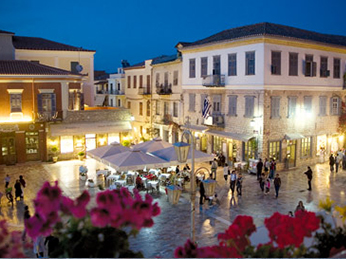

VOYLEYTIKO
Vouleytiko took its name because here was the first Greek parliament (Vouli in Greek). From autumn 1825 until spring 1826, Vouleytiko, which had been formed in the meantime by the architect Vallianos, housed the Greek Parliament. Hence the name of Vouleytiko, which is known until today. The building then worked serving several purposes: it housed the Greek School, the ground floor was prison, and here took place the Trial of the Chieftains of the Greek Revolution, Th. Kolokotronis and D. Plapoutas. Today, Vouleytiko fashioned by the Ministry of Culture, works as a conference room.
THE LION OF BAVARIAN
This is the famous Lion of the Bavarians, created in 1836 by the German sculptor Siegel, when King Ludovik, Othona’s father, asked him to build a monument to the soldiers of the Bavarian Kingdom who died of typhoid in 1833 to 1834. The artist then carved into the rock a lion, like the one that was set up in the Swiss Lucerne, in memory of their compatriots killed in Paris during the French Revolution. The locals call the sculpture and “Agouroon” (cucumber in the ancient Greek), since they support that the soldiers died because they eat many cucumbers!
